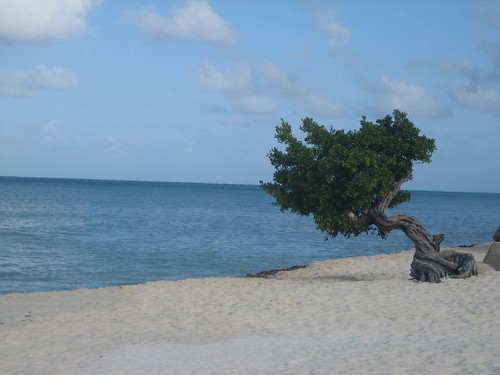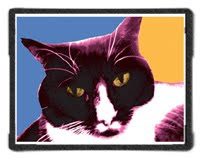Important facts about Aruba
Wow, Aruba is windy. Tie-stuff-down, hold-onto-your-hat windy. Even the native watapana trees bend at an angle because it's so freakin' windy.

It's also not American; we've heard very few English-speaking tourists so far (apart from the Bostonians on our flight, the average age of whom was 103), though many Spanish-speaking, plus Dutch (unsurprisingly, as Aruba belongs to the Netherlands) and even Luxemburgers, who are apparently used to explaining to people where Luxemburg is, exactly.
Aruba is also tiny--only 20 miles long and about 6 across. You could run all the way around it and still not have done a marathon. We flew in from the west, and I could see clear across to the far side of the island.
Its many attempts at being colonized, plus good year-round weather, mean Aruba is a collage of cultures; street signs are in Dutch, but many building names are in Spanish, and most other signs are in English. Waitrons can switch from one language to the next mid-sentence.
When it comes to the food (come on, you've been waiting for me to get to the food) this is expressed better in theory than in practice.
F'rinstance: on our cab ride from the airport to the hotel, I asked the driver where we could find real proper Aruban food.
"Oh," he said, "you should go to The Old Cunucu House. That's the real stuff: goat, pumpkin soup--you'll find all that stuff there."
Well, he was right, I guess; the menu does have goat, and Aruban fish balls, and little cheese "pastechi" (which I think translates as "pasties"). But apart from that, it's pretty much the same as every other menu on the island: lasagne, bolognese, surf and turf, shrimps (everywhere shrimps). Interestingly, escargots seems to be a default appetizer.
So The Boy opted for the goat stew, which came as a tender, moist, goaty version of a beef stew, and I had the keeshi yena, a casserole of chicken with olives, raisins and cashews, topped with melted Gouda. And I got the recipe to bring back (though frankly it didn't look too hard to figure out).
From there, we wandered over to the Hyatt and hung in a squishy pillow-filled cabana at the bar, drinking champagne and waiting until midnight (my birthday).
And then we strolled the path along the beach, passing the high-rise hotels with their winding lazy rivers and hot tubs (and we attempted to play giant beach Connect 4 but couldn't get the pieces out) and then took a taxi back to the hotel (seems taxis are the main mode of transport around here).
Today: beach, lunch (hopefully including bitterballen, which appear to be deep-fried pork balls); dinner on the beach.
Oh good--the menu includes shrimps.
Photos to follow once we get back.

It's also not American; we've heard very few English-speaking tourists so far (apart from the Bostonians on our flight, the average age of whom was 103), though many Spanish-speaking, plus Dutch (unsurprisingly, as Aruba belongs to the Netherlands) and even Luxemburgers, who are apparently used to explaining to people where Luxemburg is, exactly.
Aruba is also tiny--only 20 miles long and about 6 across. You could run all the way around it and still not have done a marathon. We flew in from the west, and I could see clear across to the far side of the island.
Its many attempts at being colonized, plus good year-round weather, mean Aruba is a collage of cultures; street signs are in Dutch, but many building names are in Spanish, and most other signs are in English. Waitrons can switch from one language to the next mid-sentence.
When it comes to the food (come on, you've been waiting for me to get to the food) this is expressed better in theory than in practice.
F'rinstance: on our cab ride from the airport to the hotel, I asked the driver where we could find real proper Aruban food.
"Oh," he said, "you should go to The Old Cunucu House. That's the real stuff: goat, pumpkin soup--you'll find all that stuff there."
Well, he was right, I guess; the menu does have goat, and Aruban fish balls, and little cheese "pastechi" (which I think translates as "pasties"). But apart from that, it's pretty much the same as every other menu on the island: lasagne, bolognese, surf and turf, shrimps (everywhere shrimps). Interestingly, escargots seems to be a default appetizer.
So The Boy opted for the goat stew, which came as a tender, moist, goaty version of a beef stew, and I had the keeshi yena, a casserole of chicken with olives, raisins and cashews, topped with melted Gouda. And I got the recipe to bring back (though frankly it didn't look too hard to figure out).
From there, we wandered over to the Hyatt and hung in a squishy pillow-filled cabana at the bar, drinking champagne and waiting until midnight (my birthday).
And then we strolled the path along the beach, passing the high-rise hotels with their winding lazy rivers and hot tubs (and we attempted to play giant beach Connect 4 but couldn't get the pieces out) and then took a taxi back to the hotel (seems taxis are the main mode of transport around here).
Today: beach, lunch (hopefully including bitterballen, which appear to be deep-fried pork balls); dinner on the beach.
Oh good--the menu includes shrimps.
Photos to follow once we get back.



0 Comments:
Post a Comment
Subscribe to Post Comments [Atom]
<< Home